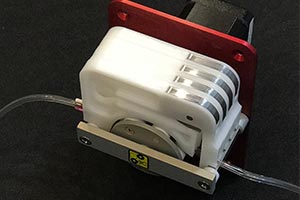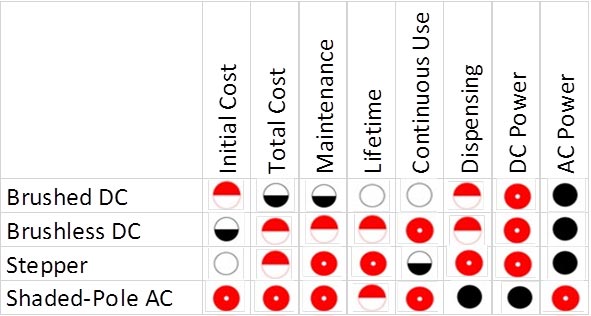Choosing the Right Motor for Your OEM Pump Solution
by Brad Blum and John Batts
Masterflex, a part of Avantor, is well-known for its high quality Masterflex® and Ismatec® pump technologies. Many OEMs turn to the Masterflex OEM team when they need a custom pump integrated into equipment they are developing. What needs to be considered when choosing a pump solution is not only the style of pump, but also the type of motor. When deciding on a motor for your OEM pump solution, keep in mind these numerous considerations.
Types of Motors
Of the many different motor types in use today, there are four motor technologies that cover most applications, each with advantages and limitations, all of which should be considered.
Brushed DC / Permanent magnet direct current (PMDC) motors
Brushed DC and PMDC motors tend to be the favored choice for cost-sensitive applications for many reasons. The initial cost of ownership is generally low. A strong feature-set is useful for many different applications. These motors incorporate internal brushes that translate electrical current to motor movement. Many motor technologies require the use of a driver to control the operation of the motor. Brushed DC motors do not necessarily need one—especially if the application only calls for the motor to operate at a fixed speed. For applications that require a driver for more advanced control, the controller for a brushed DC motor tends to be less expensive than similar controllers used with other motor technologies.
Inherent in the design of a brushed DC motor is the wear of the internal brushes which occur due to two primary factors—motor speed and the load placed on the motor. Two possible outcomes are dependent upon the type of brushed DC motor used:
- In motors with non-replaceable brushes, brush lifetime can typically vary between 500 to 4,000 hours with the actual lifetime determined by numerous factors, after which you must discard and replace the motor.
- In motors with replaceable brushes, the lifetime tends to be longer. Brushes on these motors can be replaced lowering initial maintenance costs. Because of the wear on the commutator bars (what the brushes rub against inside the motor to translate electrical power to the motor), there is a limit on how many times you can replace the brushes before the entire motor assembly must be replaced.
In addition to the wear on the brushes, a brushed DC motor also requires the use of an encoder if tight motor speed regulation is needed, increasing the initial cost and offsetting one of the primary factors of this motor technology.
Regardless of which type of brushed DC motor you select, the added maintenance required of these motors increases the overall cost of ownership. Therefore, the benefits of brushed DC motors can be best realized when incorporated into applications involving sporadic use such as dispensing.
Brushless DC / BLDC motors

Brushless DC motors are different from brushed DC motors, as there are no internal brushes used to carry the current that powers these devices. Brushless DC motors experience very little wear and require virtually no maintenance for the duration of their lifetime, which is by far the biggest advantage of working with this type of motor. As an added benefit, because there are no brushes involved in this motor’s design, there is very little particulate matter generation during operation. This makes brushless DC motors a viable option for medical devices and other similar applications sensitive to particles and debris.
The most typical failure occurs in the gear box attached to the front of the motor. The gear box reduces the motor speed and increases the torque delivered to the pump. The gears can wear over time.
Without brushes or commutator bars in the assembly, brushless DC motors need a driver board to provide the necessary electronic commutation to operate properly. Unfortunately, brushless DC motor driver boards tend to be more expensive than the driver boards used with brushed DC motors. This adds to the initial cost when working with these motors. Additionally, for tight speed control an encoder must be used, further increasing the initial cost.
Because of the brushless DC motors design, they are perfect for applications where a long lifetime is needed or where the motor is in a hazardous or difficult-to-reach location. In these applications, while the initial cost of ownership of a brushless DC motor option is higher, the total lifetime cost of ownership of the motor is the lowest, making it a solid option.
Stepper motors
Stepper motors are a type of brushless DC motor, but the motor movement is controlled differently. A stepper motor functions by dividing a full rotation into an equal number of steps. The motor can move to and hold at a specific spot in its rotation via the controlled pulses to internal electromagnets. An encoder or similar feedback mechanism is not needed. Stepper motors offer other advantages too, including long lifetime, little-to-no wear and maintenance, high starting torque, and overall cost, which typically falls between a brushed and brushless DC motor.
However, some significant limitations need to be considered when incorporating stepper motors into an application. One limitation is the change in torque that can be delivered by the motor as the speed changes. While the initial torque is high, the available torque at elevated speeds is considerably lower and can lead to rotational inaccuracies including stalling.
Additionally, some important tangible effects can also limit the use of stepper motors, including acoustic noise (they can “whine” at a high pitch), heat generation due to overall inefficiencies (which can necessitate ventilation or other cooling methods), and mechanical vibration.
While stepper motors are not the favorable choice for continuous operation applications, these motors are an excellent choice for repeated and rapid dispensing applications. They can withstand heavy use without the need for regular maintenance, and offer tight inherent positional and speed control.
Shaded-pole AC motors
Shaded-pole AC motors are another popular motor option for a limited subset of customers and applications. In the food and beverage industries, where pumps are run continuously and both initial and lifetime costs are factors, shaded-pole AC motors can offer some significant advantages:
- Low initial cost
- Low cost of ownership due to virtually no maintenance
- Long lifetime (typically only limited by gear life, like brushless DC motors)
- Operate with AC power
- Quiet operation
- No electro-magnetic interference (EMI)
Limitations to the shaded-pole AC motors should be considered as well. The biggest limitation is the fixed-speed operation of these motors. Shaded-pole AC motors are engineered to operate at a single speed, determined by the gearing ratio incorporated into their design. Encoders and other feedback mechanisms cannot be used with these motors to ensure proper rotational speed, which can lead to flow inaccuracies and variation during use.
Additionally, these motors tend to generate considerable heat, a side effect only exacerbated by continuous use. Typically, a fan must be incorporated into the design to provide real-time cooling of the motor assembly. These motors are not as powerful as the other motor types.
Given the advantages and limitations for these motors, the general recommendation is to consider shaded-pole AC motors for continuous-use applications not as sensitive to slight variations in the flow rate. For other applications, especially those involving dispensing, the better choice would be to use one of the other motor types.
Summary
To visualize the advantages and limitations of each of these motor types, review the following chart:

![]()
Excellent -------------------------> Poor
Each of the four motor options discussed in this article has advantages and limitations, and consideration must be given to each motor type when selecting the best motor for your application.